This is part 2 about Kyoto. Click here to see part 1 about Tokyo!
Riding the Shinkansen to Kyoto

Nozomi N700 for Hiroshima. (Fuji X100s)
Upon my arrival in Tokyo, one of my first missions was to book a green-car seat on the Nozomi Shinkansen to Kyoto. Nozomi is the fastest of the Shinkansen types, stopping only at major stations. It takes 2 hours and 20 minutes to reach Kyoto. Some trains, including the one I rode, go all the way to Hiroshima.
I am really proud that I managed to use my Japanese language skills to book a window-seat on the right side of the train, so that there was a chance of seeing Mt Fuji at about 20 mins from Tokyo.

An interest for trains runs in my family, but I have to say these guys were filming Shinkansen with an enthusiasm that was on a completely different level. (Fuji X100s)

N700 green car. The car was 75 % empty. So much leg room. Comfort level is extremely high. The train ride itself was worth the trip. Very relaxing. (Fuji X100s)

Ekiben. Premade Obento (lunchbox) sold on every station. It was really good. (Fuji X100s)
Kodaji temple
Kodaji temple is a really beautiful temple very close to Gion, in the Higashiyama district, on the way to Kiyomizu temple. I was fortunate to be able to visit this place at sunset, which made everything ten times more beautiful.

Garden works at Kodaji. (M6 Portra 400)

Nice view from some stairs at Kodaji. (M6 Portra 400)
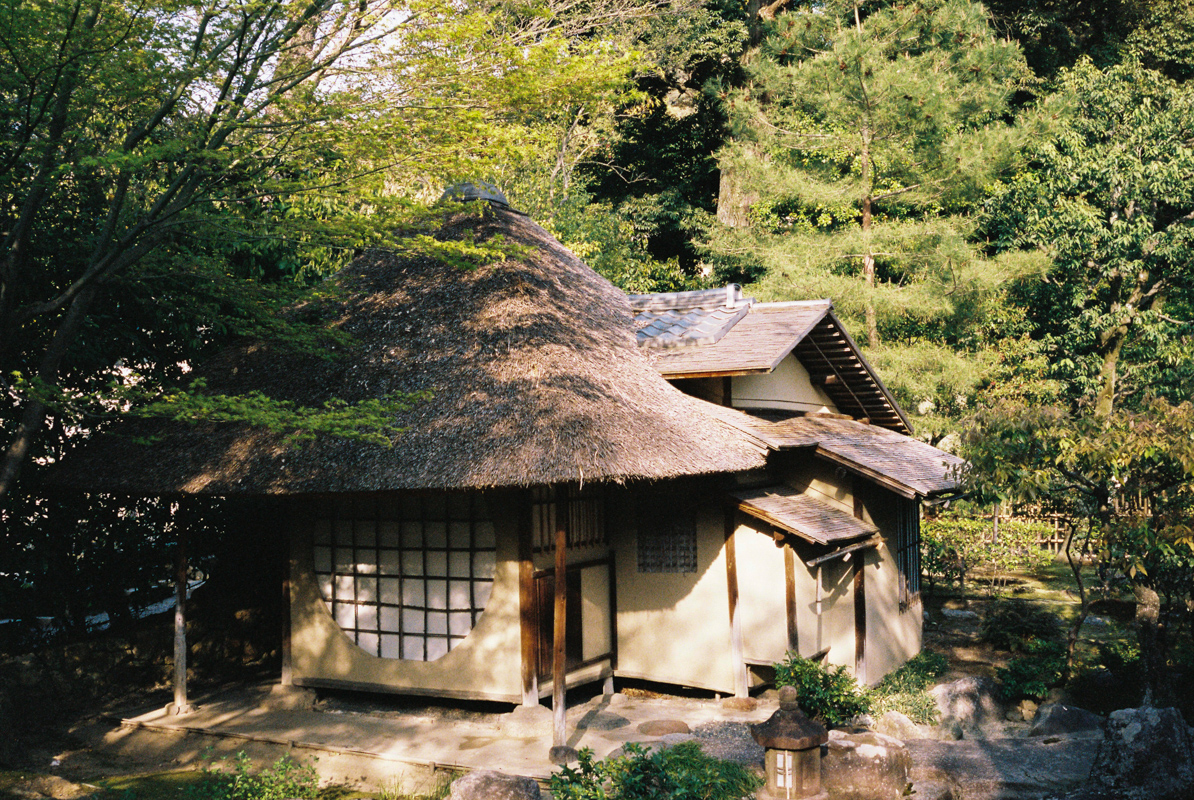
At Kodaji. (M6 Portra 400)

Kodaji. (M6 Portra 400)

Interior of Kodaji. (M6 Portra 400)
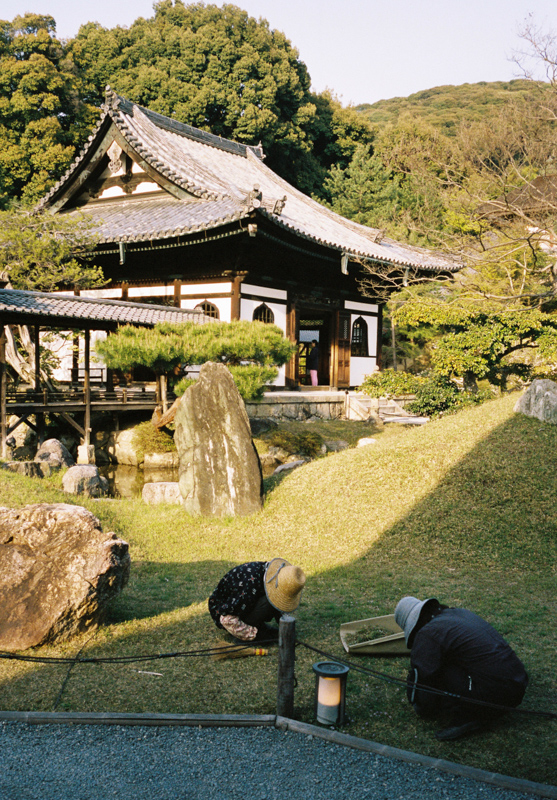

More garden works at Kodaji. (M6 Portra 400)
Yasaka shrine and Maruyama park
Yasaka shrine and the adjacent Maruyama park lies between Gion district and Higashiyama district. I loved this place. It was about 200 meter from my hotel. It was open 24 7 and it was free. A good place to relax, especially in the morning before all the tourists got there.
Apparently I forgot to take a photo of the shrine itself... oh well.

Rickshaw run outside Yasaka shrine. (M6 Portra 400)

Outside Yasaka shrine. (M6 Ektar 100)
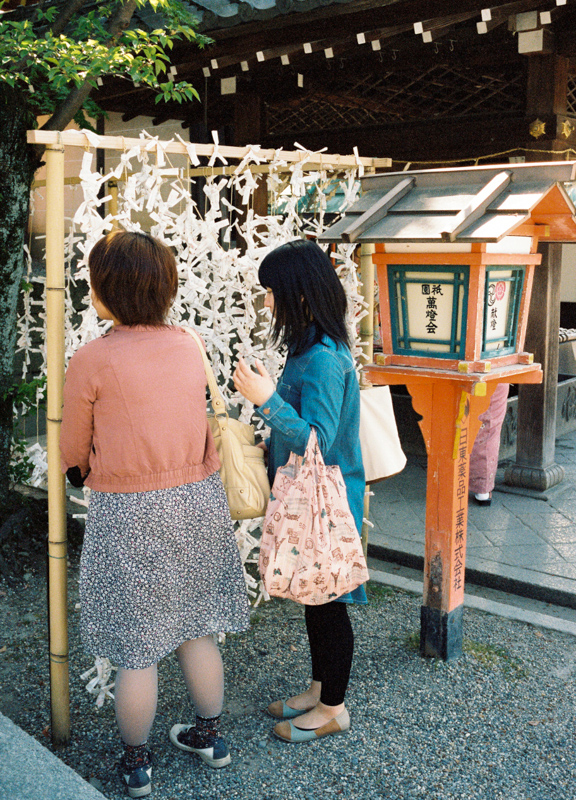

Wishes for the future and prayer and at Yasaka shrine. (M6 Portra 400)


Maruyama park, everyone was having their photo taken among the last cherry blossoms. (M6 Portra 400)


These Taiwanese girls were taking photos of each other. Suddenly they approached me. They wanted me to pose with each one of them. A tall white guy is probably a bit exotic there. (M6 Portra 400)

Maruyama park. Pretty popular. (M6 Portra 400)

Maruyama park in the morning, on my way to eat breakfast. A lot more peaceful. (M6 Ektar 100)

Maruyama park in the morning. (M6 Ektar 100)
Gion
I spent two nights in Kyoto and the first night I spent at a hotel in the middle of Gion. Gion is a beautiful district in eastern Kyoto. It is one of the active Geisha districts and has a very traditional vibe to it. Near sunset, the place was filled with limousines, taking VIP customers to expensive places for dinner and traditional Geisha entertainment. Sadly, I didn't spot any Geisha but I might have spotted a Maiko (possibly fake though).
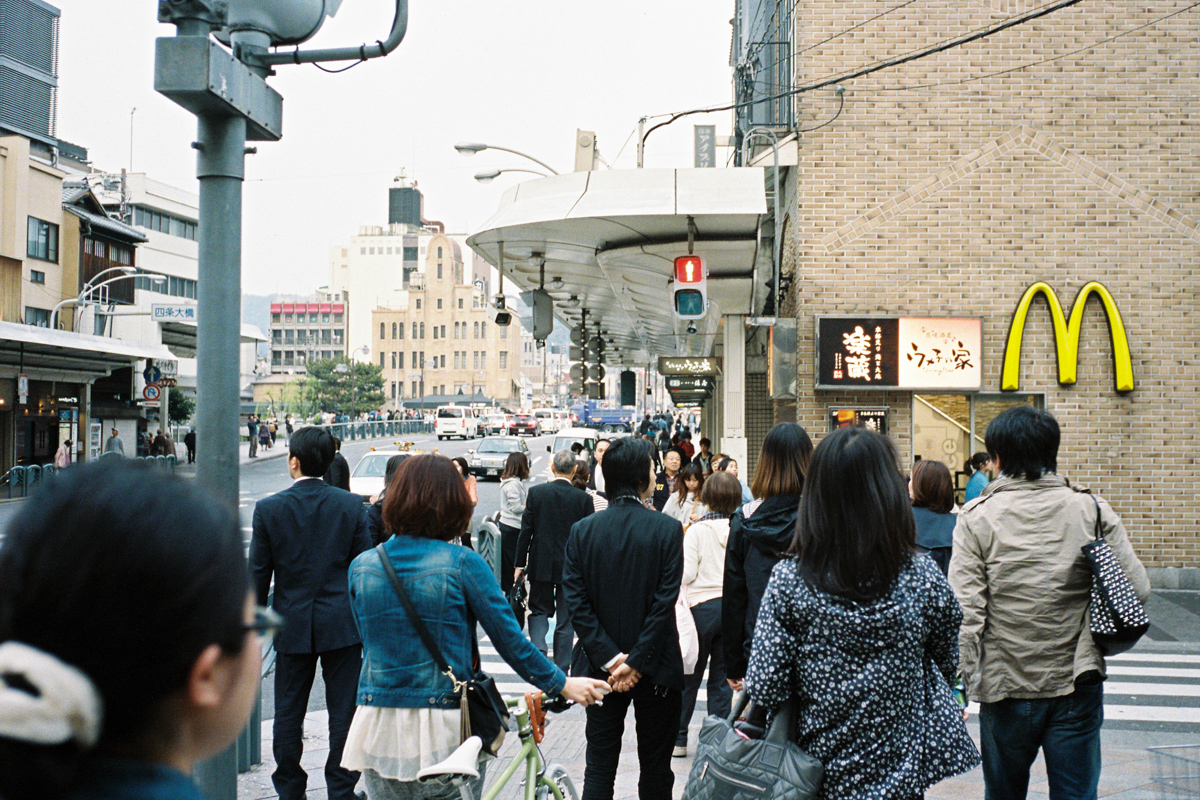
Shijo Dori next to Kamo river. On my way to Gion on the other side of the river. McD is always nearby. (M6 Portra 400)

On the bridge over Kamo river flowing beside Gion. Popular photo spot I suppose. (M6 Portra 400)

By the Kamo river. A popular place to hang out. The girls on the other side were taking selfies. (M6 Portra 400)

I walked over to the other side. The girls approached me and wanted me to take their photo. When I wanted to take a photo with my camera, they asked "what poozu?". I replied "Kawaii poozu!" . This is what I got. (M6 Portra 400)

Hanami Koji in the early afternoon. They removed all the electrical poles to make it look like in the old days. It's a gorgeous and very romantic street. Filled with tourists during the day. (M6 Portra 400)

Hanami Koji before lunch. Slightly less crowded. (M6 Ektar 100)

Please come in and take a break! (M6 Ektar 100)

Ramen sign needs lamp replacement. (Fuji X100s)

Spotted Maiko on their way to someplace (not sure if they were real or fake). I was too slow to get really close and I didn't really want to follow them. (M6 Portra 400)

Gion. I loved this place. (Fuji X100s)

Hanami Koji at night, on my way to dinner. Peaceful and atmospheric without (well, with less of) the tourists. (Fuji X100s)
Pontocho
Pontocho is a narrow alley going parallel with the Kamo river, from Shijo dori to Sanjo dori. The alley is filled with restaurants. It is also another active Geisha district, just like Gion. Didn't see any Geisha here either though!
The course for the evening was takoyaki and okonomiyaki, typical Japanese street food. Really good and not very expensive!
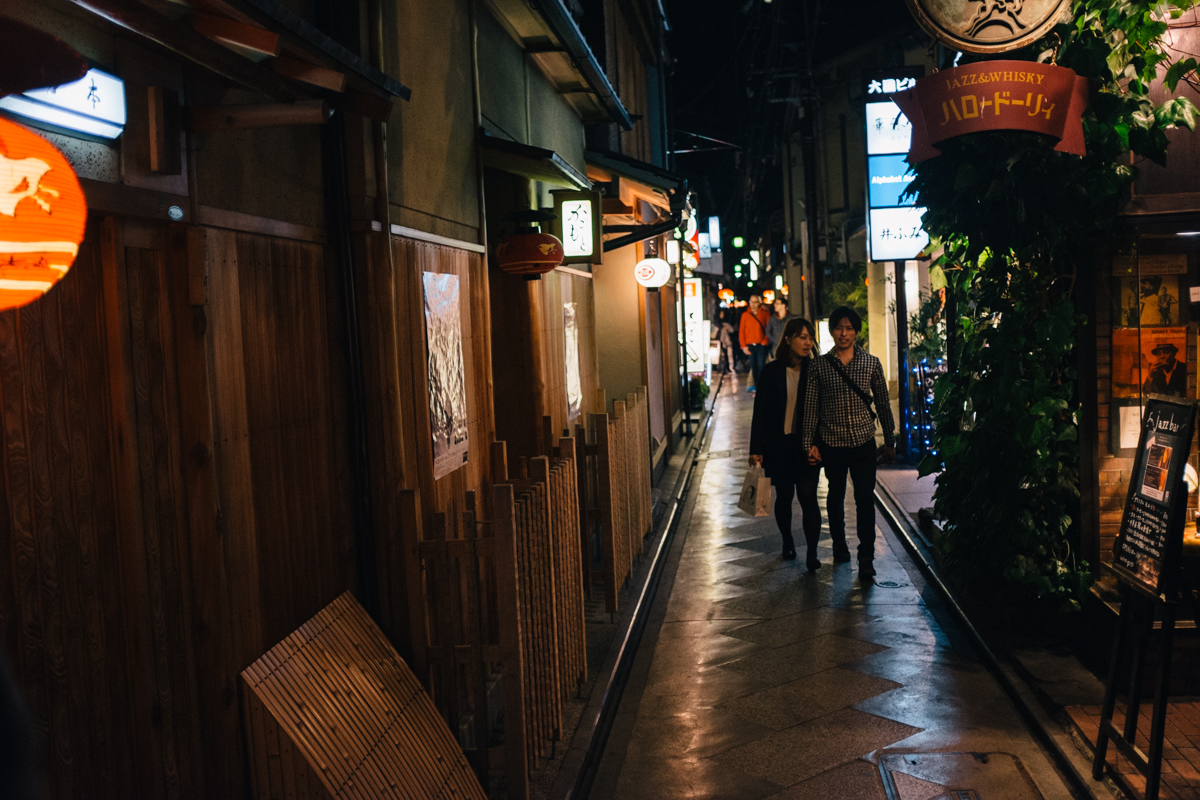
Pontocho, so many choices of places to eat and drink.(Fuji X100s)

Outside a restaurant in Pontocho (Fuji X100s)
Arashiyama
Going to Arashiyama was one of the things I had been looking forward to the most. Arashiyama is a scenic region in west Kyoto, with bamboo forests, mountains, temples - a haven for people who enjoy nature. Seeing photos from the place beforehand made me really excited to go because I love spending time in nature. I was not disappointed.
Because I had made a weird decision to stay at two different hotels during my stay in Kyoto, I checked out from the hotel in Gion, took the Keihan main line to Tofukuji, switched trains to the JR Nara line and headed for Kyoto station to drop off my back pack, so I had less stuff to carry around for a day of trekking.
Turns out Arashiyama is quite a popular destination, especially during the day.

An express train for Arashiyama was ready to depart at Kyoto station. Turns out everybody was on it. (Fuji X100s)
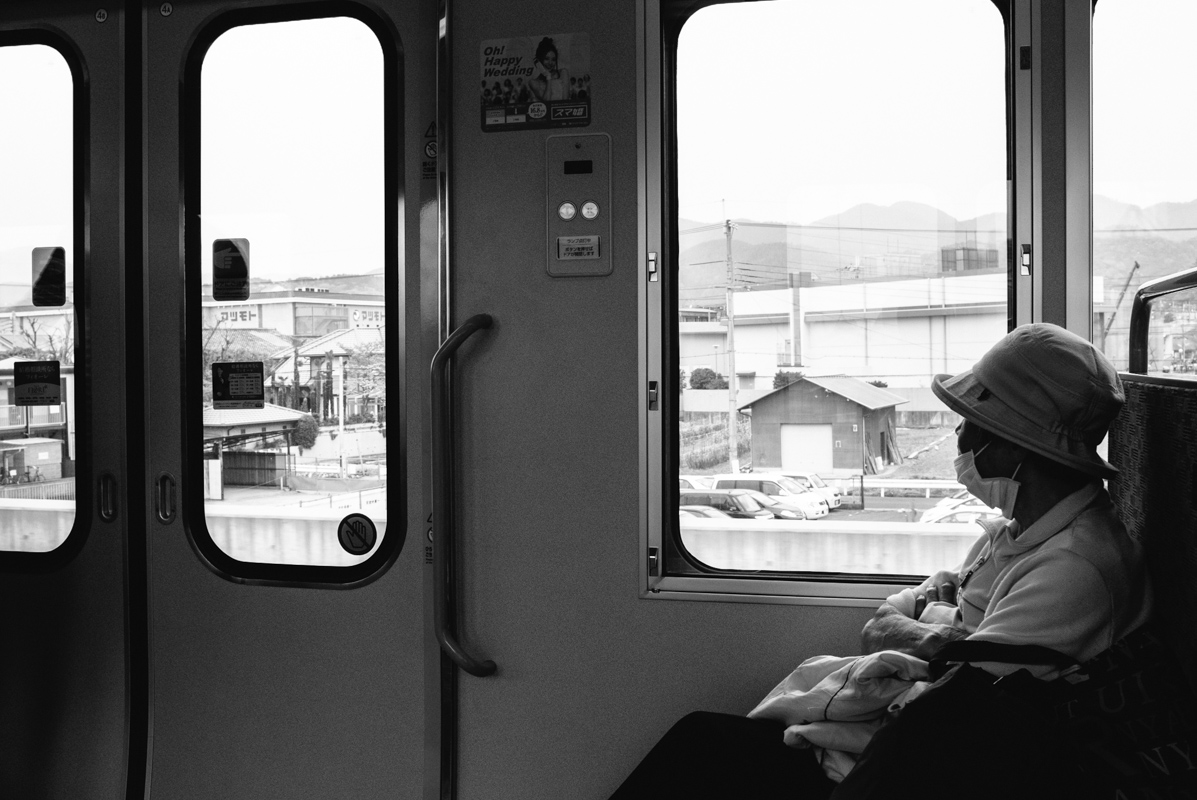
I waited for the next local train which, as it turned out, was almost empty. (Fuji X100s)

On my way from the railway station to the bamboo path. Met a family with really excited kids. (Leica M6, Ektar 100)


Walking the Arashiyama bamboo path was truly breathtaking. (Leica M6, Portra 400)


Bamboo trees. (Leica M6, Ektar 100)


After losing the hordes of tourists at the Sagano romantic railway station I found a small and romantic cafe where ordered coffee and a small and romantic piece of cake. (L: M6 Ektar 100, R: Fuji X100s)

At Jojakkoji temple, an small temple with an amazing garden. It was well hidden and had almost no tourists at all. Refreshing! (M6 Ektar 100)

At Jojakkoji temple. I spent the time walking around in the beautiful Japanese garden. (M6 Portra 400)

At Jojakkoji temple. (M6 Portra 400)


At Jojakkoji temple. (M6 Portra 400)

Jojakkoji. After some climbing I came to a good view point with a really nice view of Arashiyama.. (M6 Portra 400)

Katsura river. (M6 Portra 400)
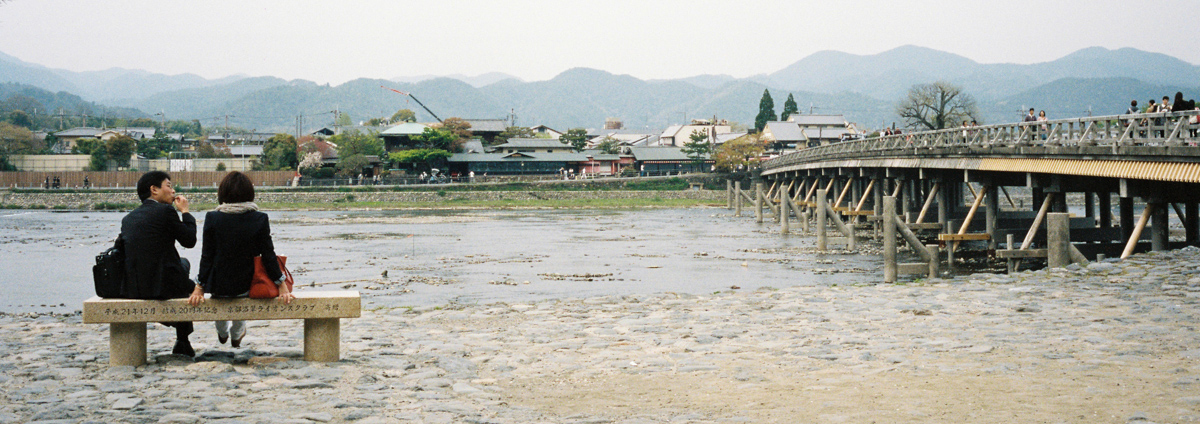
Togetsukyo Bridge over Katsura river. (M6 Portra 400)

The teacher was very interested in my Leica. We talked for a bit. He showed the camera to his students. Then he made them ask me questions in English. One of my favorite moments this trip! (Portra 400)
Kyoto City Center
The second night I stayed at a hotel residing directly in Kyoto station. I found the area a bit boring compared to Gion but I guess I wasn't easily impressed after an amazing day in Arashiyama. But I went out and took some photos in the neighbourhood.


Kyoto tower and Makudonarudo. (Fuji X100s)

Yup. They have Yodobashi Camera in Kyoto too. (Fuji X100s)
Fushimi Inari
On the morning of the day I was to return to Tokyo, I decided to check out Fushimi Inari Shrine. Fushimi Inari is an area south of Gion. The shrine is very famous for its thousand torii gates. These can be seen for example in the movie Memoirs of a Geisha. Because of the massive amounts of tourists I decided not to follow the path all they way up on Mt Inari. I'll return some day and do the trek all the way, super early in the morning!

Entrance of the Inari Taisha. Inari is the Shinto God of rice. (M6 Ektar 100)


The fox is the messenger of Inari. (M6 Ektar 100)

Start of the trail to the top of Mount Inari. It takes about 2-3 hours to the top and back. (Fuji X100s)

A few of the thousand torii gates. One of few milliseconds when there almost weren't any tourists visible. (Fuji X100s)
Kiyomizudera
After my shortened visit to Fushimi Inari shrine, I had plenty of time until my train left for Tokyo, so I decided to go to another famous place in Kyoto, namely Kiyomizu temple.
There are two different railway stations at Fushimi Inari, one for the JR Nara line which I had used in the morning, and one for the Keihan line for Gion. Since I was going to Gion to walk to Kiyomizu temple, I headed for the Fushimi Inari Keihan station. This was the first time I got slightly lost because I took the wrong turn somewhere and ended up at the next station along the Keihan line. No biggie though, it was nice weather and I got to see some more of Inari.

Stairs at the entrace of Kiyomizu temple. (M6 Ektar 100)

Kiyomizu temple. A lot of it was under reconstruction but there was still plenty to see. I imagine this spectacular during cherry blossoms. (M6 Ektar 100)
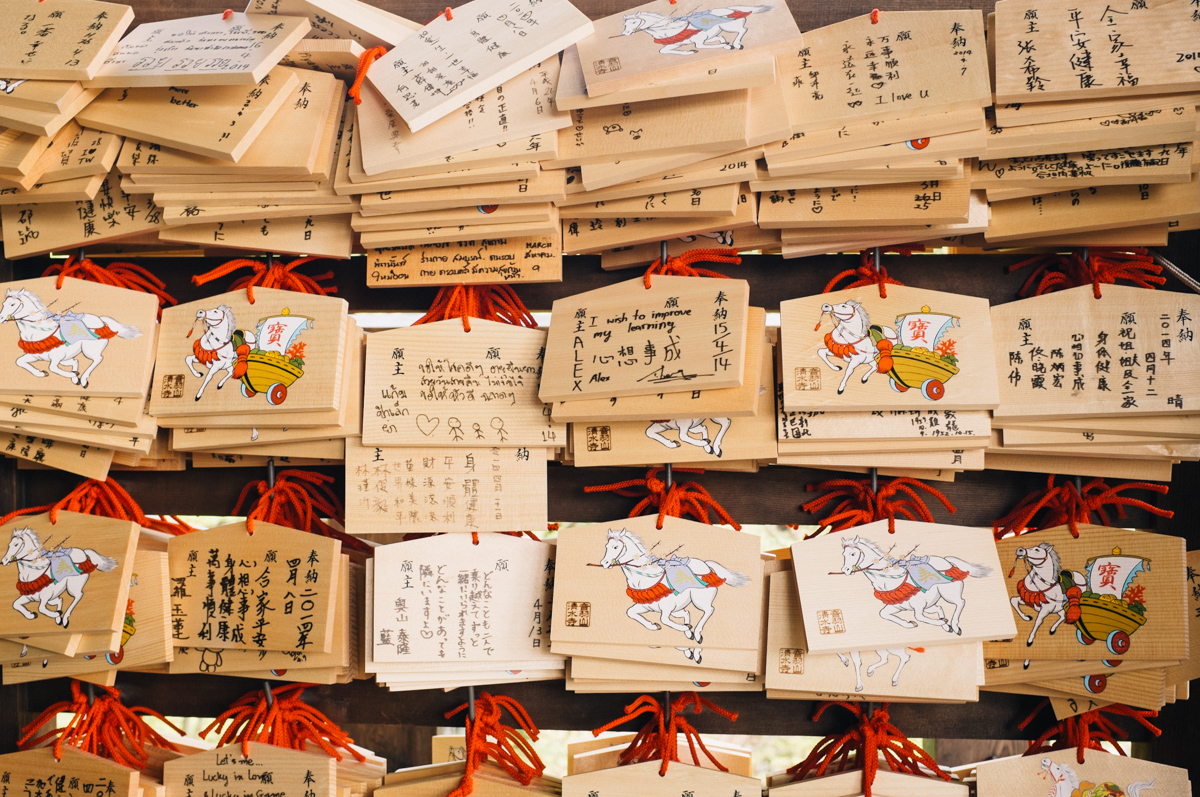
Make a wish.(Fuji X100s)
>
Some school kids enjoying the view of Koyasu Pagoda.(Fuji X100s)

People drinking one of three water streams (said to give longevity, success at school, and a fortunate love life, respectively) at Otowa waterfall (Fuji X100s)

A fence.(M6 Ektar 100)

Prehistoric streets with shops, in Higashiyama district on my way from Kiyomizudera. Seems I wasn't the only one that was visiting the temple. (M6 Portra 400)

Higashiyama, going back from Kiyomizu. The hottest day of the trip and I was eager to find a vending machine with water. (M6 Portra 400)
Nishiki Market
On my last evening in Kyoto I decided to make a brief visit to Nishiki Market, a long shopping mall with a lot of stores.

Nishiki Market. Lots of food shops and restaurant. (M6 Portra 400)

A little restaurant in the middle of Nishiki Market. Inexpensive and delicious. (Fuji X100s)

Kitsune Udon. Said to be the favorite food of the fox. It was so damn good. (Fuji X100s)

Gochisousama. Mata kimasu ne. (Fuji X100s)
Kyoto, final words
In retrospect, two days is not enough for Kyoto. I'd say a week at least to be able to enjoy a few of the many things to see, rather than rushing though them. I quickly scratched things off my todo-list in order to be able to fully enjoy the things i prioritized most. I am happy I made that decision because Kyoto was truly a marvelous, relaxing and enchanting experience for me.
Tokyo
This is part 2 about Kyoto. Click here to see part 1 about Tokyo!